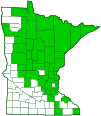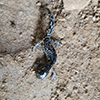blue-spotted salamander
(Ambystoma laterale)
Conservation • Description • Habitat • Biology • Distribution • Taxonomy
Conservation Status |
|
|||||||
| IUCN Red List | LC - Least Concern |
|||||||
| NatureServe | N5 - Secure S5 - Secure |
|||||||
| Minnesota | not listed |
|||||||
Description |
||
Blue-spotted salamander is a medium-sized, very cold-tolerant, mole salamander. It occurs in the northern United States and southern Canada from Quebec and New Jersey in the east to Iowa and eastern Manitoba in the west. In Minnesota it is common in the northeast and there are scattered populations in remnant forests in the south. It is found in flat forested areas with permanent ponds. It is often discovered under logs. Adults are The body is stout with four well-developed limbs that project sidewards. The trunk is cylindrical. The tail is broad and oval at the base, becoming cylindrical as it approaches the tip. It is long, comprising about 40% of the salamander’s total length. The skin is soft, moist, and dark brown, black, or bluish-black. There are numerous pale blue or bluish-white spots and flecks on the lower sides of the trunk and tail, fewer or absent on the upper (dorsal) surface. There are usually 12 or 13, sometimes 14, prominent vertical depressions (costal grooves) on each side between the forelimbs and the ventral area. The belly is usually lighter and flecked. The vent is black. The head is moderately large, distinctly wider than the neck. The legs are relatively short but the toes are relatively long (compared to other salamanders). Juveniles are dark brown. They have yellowish blotches on the back and a yellow stripe on each side. |
||
Size |
||
|
||
Similar Species |
||
Habitat |
||
Forests and wetlands |
||
Biology |
||
Behavior |
||
The adult spends most of the year under a log or other cover. When threatened it holds its tail up and curved over the body. Small, granular glands, concentrated mostly on the tail, exude a milky, unpleasant tasting liquid in response to a predator. |
||
Lifespan |
||
Unknown |
||
Life Cycle |
||
Breeding occurs in April in small woodland ponds and ditches. The female lays eggs individually or in groups of 2 to 4, attaching them to leaves or other debris at the bottom of the pond. The eggs hatch in about a month. Adults are not freeze tolerant. It is thought that they burrow below the frost line to overwinter. |
||
Larva Food |
||
Insects, mosquito and other insect larvae, water fleas, copepods, and other small aquatic invertebrates. |
||
Adult Food |
||
Earthworms, beetles, spiders, centipedes, snails, slugs, and other invertebrates. |
||
Distribution |
||||
|
Sources |
|||
| 9/15/2022 | ||||
Occurrence |
||||
|
||||
Taxonomy |
|||
| Class | Amphibia (amphibians) | ||
| Superorder | Batrachia (frogs and salamanders) | ||
| Order | Caudata (salamanders) | ||
| Suborder | Salamandroidea (mole salamanders) | ||
Family |
Ambystomatidae (mole salamanders) | ||
Genus |
Ambystoma (mole salamanders) | ||
Disagreement persists about the use of the names Caudata and Urodela for the order of salamanders. Some authors use Caudata for the crown group and Urodela for the total group. Currently (2023), most authors use Urodela for the crown group and Caudata for the total group. |
|||
Subordinate Taxa |
|||
|
|||
Synonyms |
|||
Ambystoma nothagenes Ambystoma platineum Ambystoma tremblayi Amblystoma laterale |
|||
Common Names |
|||
blue-spotted salamander |
|||
Visitor Photos |
|||||
Share your photo of this amphibian. |
|||||
| This button not working for you? Simply email us at info@MinnesotaSeasons.com. Attach one or more photos and, if you like, a caption. |
|||||
Finley Beck |
|||||
small, ~3” long |
|||||
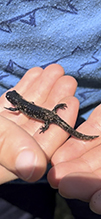 |
|||||
Charity |
|||||
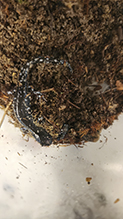 |
|||||
Luciearl |
|||||
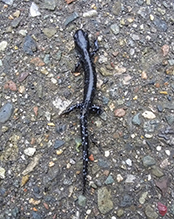 |
|||||
David Scott |
|||||
I found 4 of them under a tarp in my sand floor of a pole barn. All were the same size. About 3 inches long. |
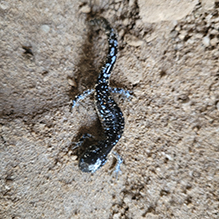 |
||||
Dallas Barber |
|||||
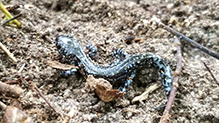 |
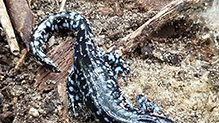 |
||||
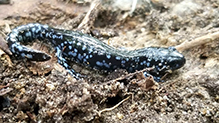 |
|||||
MinnesotaSeasons.com Photos |
|||||
|
|||||

Slideshows |
||
|
||

Visitor Videos |
|||
Share your video of this amphibian. |
|||
| This button not working for you? Simply email us at info@MinnesotaSeasons.com. Attach a video, a YouTube link, or a cloud storage link. |
|||
Other Videos |
|||
| Blue-spotted Salamander (Ambystomatidae: Ambystoma laterale) on Sand Carl Barrentine |
|||
About
Published on Sep 9, 2010 Photographed at the Concordia Language Villages, Bemidji, Minnesota (07 September 2010). |
|||
| Blue-spotted Salamander (Ambystoma laterale) 10/4/15 Wisconsin Dells lyubakavideo |
|||
About
Published on Oct 4, 2015 Look who I met under my boat today a pair of Blue-spotted Salamanders (Ambystoma laterale) This is a relatively slender blue-black salamander with whitish or blue spots on its back. It has four toes on its front feet and five on its hind feet. The costal (rib) grooves are very pronounced along the body between the front and rear legs. A triploid variant of this species, consisting exclusively of females, is found in parts of northern Wisconsin. The variants tend to be longer and paler than the blue-spotted salamanders. Blue-spotted salamanders prefer both northern and southern hardwoods and coniferous forests. They are often abundant in lowland hardwood forests. They tolerate dryer conditions than most Wisconsin salamanders, often living in forests with sandy soils. Adults eat many types of invertebrates including earthworms and insects. Blue-spotted Salamander (Ambystoma laterale) 10/4/15 Wisconsin Dells Latest Reports FishVids.BlogSpot.com bit.ly/DellsFishing Don't forget to subscribe | like | share | comment |
|||
| Blue-Spotted Salamander - Wild ID American Wilderness |
|||
About
Published on May 27, 2016 We wanted to show you some of the cool blue-spotted salamanders (Ambystoma laterale) we found recently in Wisconsin. In this series, we show you species that you could easily encounter in the outdoors, and how you can identify them. Wild ID Subscribe to us on YouTube Shop at Timberlee Tool & Trade Follow us on Twitter Like us on Facebook |
|||


Created: 9/15/2019
Last Updated:
